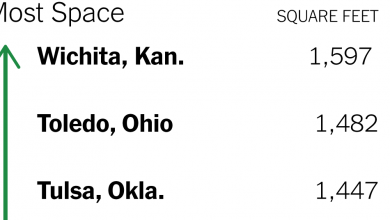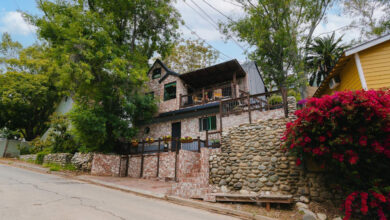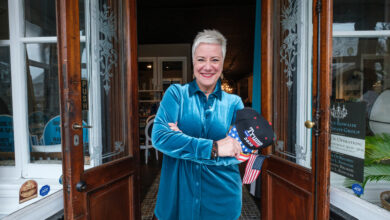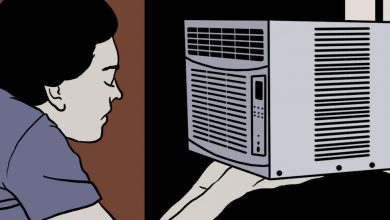Redesigned with Amenities, the Chippendale Building Tries to Lure Workers

[ad_1]
The Chippendale building, officially called 550 Madison, was designed by Philip Johnson and completed in 1984, and its neoclassical arch and pink granite were hard to miss.
Once home to Sony and AT&T, it remains an eyesore to some, but to others, like James Harris, who has worked in the building since 1996 and is currently the lead safety director, there is “something special” about the building that sits on East 55th Street and Madison Avenue.
As people return to the office after working remotely for the past few years, the building is now is aiming to offer workers something they can’t get in their living rooms or neighborhood coffee shop — “collaboration and being in the office,” Erik Horvat, the head of real estate at Olayan America, an investment group, said.
The developers at 550 Madison Avenue are banking on amenities — a gym, a full kitchen, an outdoor garden.
Not everyone is a fan of the renovations, especially preservationists hoping to keep the building in its postmodern state. In 2017, the architecture critic Alexandra Lange said the proposed renovations to the building’s facade cut Johnson’s “groundbreaking postmodern tower off at the knees,” likening it to an Apple store. A Change.org petition “aggressively dedicated” to the building’s preservation garnered just over 2,550 signatures. (The building received landmark status in the summer of 2018, with the committee calling 550 Madison one of the world’s “most important postmodernist buildings.”)
“When working on an architecturally important building like 550 Madison there are always passionate opinions from people who truly care about the city’s built environment. We listened and learned, pivoting to address feedback from the preservation community. The process ultimately led to a better product,” Mr. Horvat later said in a statement.
The renovation is a collaborative project: The architecture firm Snøhetta took on the design for the outdoor garden space, while the Rockwell Group designed the amenity spaces. The insurance firm Chubb and the French luxury brand Hermès signed a deal for space in the building, but will workers want to come back?
These interviews have been lightly edited for clarity.
Erik Horvat, head of real estate, Olayan America
There is no magic pill that you take that makes everybody come back to work. What I’ve seen be successful so far for us was you create healthy, beautiful spaces that people want to work at. That’s the best you can do right now. Do people still want the flexibility to be home for the guy that needs to check the sink that doesn’t work? Yeah. But, ultimately, you’ll bring more people back to the office if you have space.
There are a lot of challenges in the office building, and I would tell you that this is the type of office building everybody I think in the city would hope to have.
What’s become bigger with office buildings since the pandemic: It’s health and wellness, and it’s amenities. Those are two things people believe will bring people back.
Michelle Delk, partner and landscape architect
One thing that was really interesting to us when we began looking at the space was how it could become both a complement and a contrast to other publicly accessible spaces in the neighborhood. So there are other pop spaces: There’s the MoMA sculpture garden that is somewhat nearby. When we started looking at those spaces, there was a lot of interest, but we did also recognize that a lot of them were fully enclosed. So we began to think, how can this be as four seasons as possible, but be a little bit different?
And so we have always seen the public space as a space meant to invite people back over and over again. So variety, intrigue, seasonality — that access to being outside in all four seasons.
In terms of the future worker — as well as others in the neighborhood — we’re just hoping that it provides a sense of pause, a sense of retreat, whether that’s the way you start your day. Maybe you go and sit in the garden before you go into work, or if you’re working in the building and you come out to have a break or lunch or after work, that it feels like it’s a part of your every day rather than something that is forgotten or overlooked or that you only use every now and again.
James Harris, the lead fire and life safety director at Mulligan Security
I was a relatively young lad when I came here. I wasn’t in security for a long period of time. I had just left Wall Street as an accountant, and I was looking for a job, and I fell into security. I bounced around from place to place, and when I landed in this particular building — it was something special about the building. I could feel it. I never experienced that walking into any other building.
I was able to go to college and take courses to help enrich my getting ahead up the ladder. And what I enjoyed most of all was coming in contact with people. It’s just exciting to be a part of this and to be able to offer my spiritualness or how I feel to the new tenants that’ll be coming on board.
We put forth a great effort and training to be the best customer service personnel you can get. And we want them to feel like we feel by doing the job we do. And when they walk through, you want them to feel like, “Wow, I’m in a whole different universe.” We just want them to come in and feel right at home whenever they come.
Brad Zuger, Rockwell Group
To us, wellness is more than the ventilation and light — and we know that’s important. But for us, it’s also about joy and creating spectacular spaces where people can get together, particularly post-Covid.
It’s interesting to think about the array of spaces we have here and how they sort of change or adapt or allow for flexibility in how people are getting together and meeting and gathering. That was important to us. Through all these different spaces, there are a lot of layers that we’ve incorporated into the design.
[ad_2]
Source link






